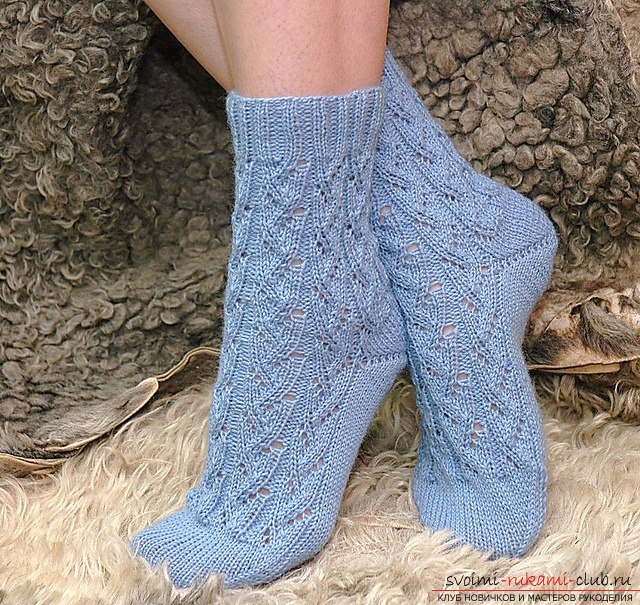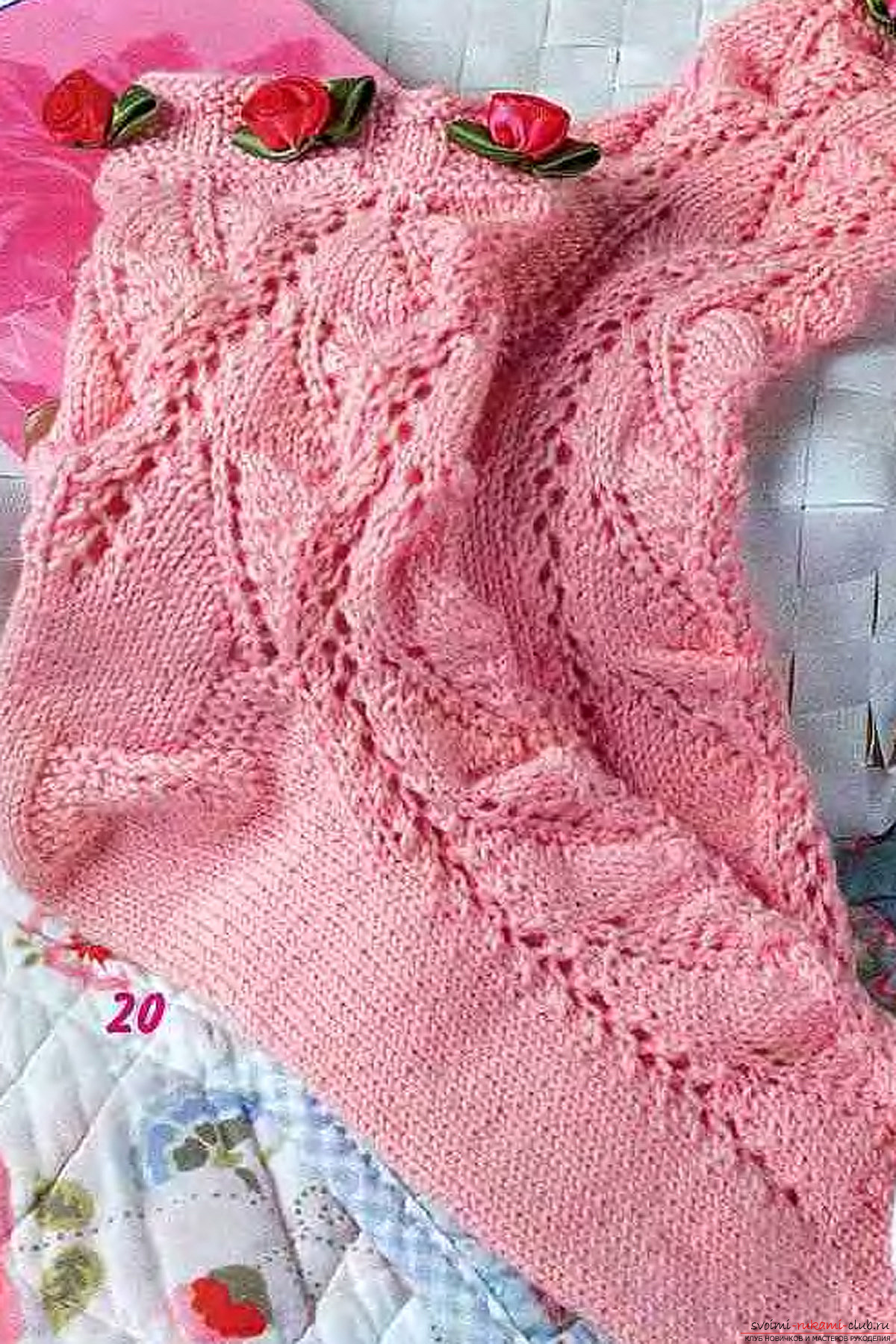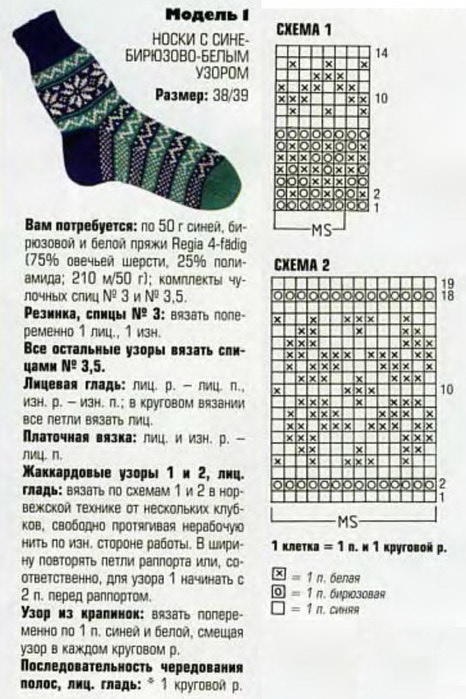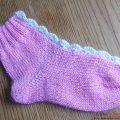
Knitting the original openwork socks with knitting needles. Knitting pattern of knitted fishnet socks with a description
Many craftsmen consider knitting of socks boring andmonotonous occupation. This opinion can be argued. To date, there has appeared a great variety of different schemes and instructions for knitting socks, among which every female needlewoman can choose her own model of socks.  Such an original model can be openworksocks. A pair of these socks will be relevant for demi-season shoes. Knitted fishnet socks turn out to be thin, but at the same time warm, which makes them an indispensable part of women's wardrobe in cool weather.
Such an original model can be openworksocks. A pair of these socks will be relevant for demi-season shoes. Knitted fishnet socks turn out to be thin, but at the same time warm, which makes them an indispensable part of women's wardrobe in cool weather.  Openwork socks will be able to connect any needlewoman. It is enough to make some efforts, allocate time and carefully study the instruction. So, let's start knitting openwork socks on knitting needles. To create the product we need 100 grams of thread. You can use yarn, which contains 75% wool and 25% polyamide. We will also need stocking knitting needles No. 2.5. This instruction describes knitting of fishnet socks 38-40 in size. 1. We collect 66 loops and knit 2 circles with the front loops all the rows. Then follows an elastic band for 6 laps.
Openwork socks will be able to connect any needlewoman. It is enough to make some efforts, allocate time and carefully study the instruction. So, let's start knitting openwork socks on knitting needles. To create the product we need 100 grams of thread. You can use yarn, which contains 75% wool and 25% polyamide. We will also need stocking knitting needles No. 2.5. This instruction describes knitting of fishnet socks 38-40 in size. 1. We collect 66 loops and knit 2 circles with the front loops all the rows. Then follows an elastic band for 6 laps. 2. Since we socks are openwork, not warm, on the rise of the shin will be a pattern, not an elastic band 2x2. 3. In this product, a toe, a foot and a back part of the sock are sewn on the face surface. For this purpose, only elastic bands are sewn on 15 loops, and the remaining 51 are sewn with a facial pattern.
2. Since we socks are openwork, not warm, on the rise of the shin will be a pattern, not an elastic band 2x2. 3. In this product, a toe, a foot and a back part of the sock are sewn on the face surface. For this purpose, only elastic bands are sewn on 15 loops, and the remaining 51 are sewn with a facial pattern. 4. In the process of knitting each facial row is subtracted evenly, until there are no more loops left. At this point, we begin to knit the openwork patterns of our socks. In this model we use two figures - an elastic band 1x1 and an openwork pattern. How to knit an elastic band, you already know, and the openwork pattern is executed according to the scheme. 1. We knit 2 facial (LP); further 2 loops tied together (2PV), a cap between two loops (H2P), remove the loop as we remove the front one, then we untie the usual front loop through the previously removed (PLSn), 3 LP, 2PV, H, N, PLSn 3 LP, 2PV , Н, Н, ПЛСн, 2 LP. 2. We knit all the face loops 3. 1 LP, 2PV, 1 LP, H, 1, LP, PLSn, 1 LP, 2PV, 1 LP, H, 1 LP, PLC, 1 LP, 2PV, 1 LP, Н, Н, 1 ЛП, ПЛСн, 1 LP. 4. All facial loops. 5. 2PV, 2 LP, H, H, 2 LP, remove the 1st loop as the front one, tie the two loops along the front one and stretch it through the removed one (Л 2 ЛС), 2 ЛП, Н, Н, 2 ЛП, Л 2 LS, 2 LP, H, H, 2 LP, PLC 6. All facial loops. 7. Н, ПЛСн, 3 LP, 2PV, Н, Н, ПЛСн, 3 LP, 2ПВ, Н, Н, ПЛСн, 3 LP, 2ПВ, Н. 8. All the front loops. 9. 1 LP, N, PLSn, 1 LP, 2PV, 1 LP, N, H, PLC, 1 LP, 2PV, 1 LP, N, H, PLC, 1 LP, 2PV, 1 LP, N.
4. In the process of knitting each facial row is subtracted evenly, until there are no more loops left. At this point, we begin to knit the openwork patterns of our socks. In this model we use two figures - an elastic band 1x1 and an openwork pattern. How to knit an elastic band, you already know, and the openwork pattern is executed according to the scheme. 1. We knit 2 facial (LP); further 2 loops tied together (2PV), a cap between two loops (H2P), remove the loop as we remove the front one, then we untie the usual front loop through the previously removed (PLSn), 3 LP, 2PV, H, N, PLSn 3 LP, 2PV , Н, Н, ПЛСн, 2 LP. 2. We knit all the face loops 3. 1 LP, 2PV, 1 LP, H, 1, LP, PLSn, 1 LP, 2PV, 1 LP, H, 1 LP, PLC, 1 LP, 2PV, 1 LP, Н, Н, 1 ЛП, ПЛСн, 1 LP. 4. All facial loops. 5. 2PV, 2 LP, H, H, 2 LP, remove the 1st loop as the front one, tie the two loops along the front one and stretch it through the removed one (Л 2 ЛС), 2 ЛП, Н, Н, 2 ЛП, Л 2 LS, 2 LP, H, H, 2 LP, PLC 6. All facial loops. 7. Н, ПЛСн, 3 LP, 2PV, Н, Н, ПЛСн, 3 LP, 2ПВ, Н, Н, ПЛСн, 3 LP, 2ПВ, Н. 8. All the front loops. 9. 1 LP, N, PLSn, 1 LP, 2PV, 1 LP, N, H, PLC, 1 LP, 2PV, 1 LP, N, H, PLC, 1 LP, 2PV, 1 LP, N.  10. All facial loops. eleven. Н, 2 ЛП, Л 2 ЛС, 1 ЛП, Н, Н, 2 ЛП, Л 2 ЛС, 1 ЛП, Н, Н, 2 ЛП, Л 2 ЛС, 1 ЛП, Н, 1 ЛП. 12. All facial loops. The openwork pattern knits about 16 cm. Next, you need to leave 15 loops for knitting gum and 8 loops on each side for the heel. The heel is made with a facial pattern. We knit according to the standard scheme - 6 cm on the rise, then we divide all the loops into 3 parts so that there are the same number of loops on the side spokes, and we only knit medium loops. At the same time, the reduction is due to side loops. As you can see, the knitting pattern of open-work socks is not complicated, as it seems initially. Try to start knitting fishnet socks and you will get a real pleasure from the work and from the result obtained.
10. All facial loops. eleven. Н, 2 ЛП, Л 2 ЛС, 1 ЛП, Н, Н, 2 ЛП, Л 2 ЛС, 1 ЛП, Н, Н, 2 ЛП, Л 2 ЛС, 1 ЛП, Н, 1 ЛП. 12. All facial loops. The openwork pattern knits about 16 cm. Next, you need to leave 15 loops for knitting gum and 8 loops on each side for the heel. The heel is made with a facial pattern. We knit according to the standard scheme - 6 cm on the rise, then we divide all the loops into 3 parts so that there are the same number of loops on the side spokes, and we only knit medium loops. At the same time, the reduction is due to side loops. As you can see, the knitting pattern of open-work socks is not complicated, as it seems initially. Try to start knitting fishnet socks and you will get a real pleasure from the work and from the result obtained.




